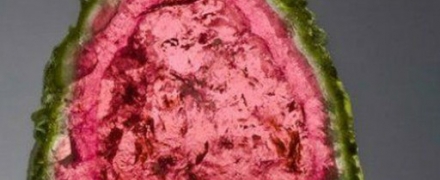open 10 am - 7 pm
laboratory is closed
Watermelon tourmaline - a berry in gemology

Among the vast group of tourmalines, you can find an unusual variety, similar to a freshly cut piece of watermelon. It has several zones, differing in color and saturation, moving from a pink-red middle to a green edge, like a real watermelon. What is the reason for this color change?
Initially, it should be noted that tourmalines are characterized by a wide range of isomorphism. The main elements between which it occurs are Na, Ca, K, Mg, Fe2 +, Mn2 +, Fe3 +, Al3 +, Li, Cr3 +. Such a wide substitution scheme is associated with the presence of "antigorite islands" in the crystal structure of tourmaline, which are based on rings of silicon-oxygen octahedra and Y-tetrahedra interconnected by a framework that is easily subject to changes. The nature of the varied colors of tourmalines is directly related to the presence of different-grade chromophore elements, such as iron and manganese, as well as impurities of titanium, chromium, vanadium and copper in their composition. The color distribution in tourmaline is concentric or cross-banded and is characterized by sharp color boundaries reflecting the change in the chemistry of mineral-forming solutions. The sequence of changing colors can be very diverse.
A striking example of zonal coloration is watermelon tourmaline. Mineralogically, it belongs to elbaite, the central pink part of which is composed of rubellite, and the green border is verdelite, or vice versa.
Often, watermelon tourmalines are processed in the form of flat-polished plates or cabochons and fixed into products. With this treatment, the colors of tourmaline become more saturated and vivid, and the color zoning is clearer.
В геммологической практике бывают весьма увлекательные случаи с диагностикой ювелирных вставок
Но помимо редкости цвета и высокой стоимости таких камней, многие розовые камни выделяются одной замечательной особенностью – они проявляют плеохроизм, то есть в зависимости от положения осмотра камня он может иметь дополнительные оттенки – оранжевый или пурпурный.
Currently, gemstones are produced by two fundamentally different technological methods - the High Pressure - High Temperature method (“HPHT”, High-pressure & High-temperature) and the Chemical Vapor Deposition (“CVD”, Chemical vapor deposition) method. The "HPHT" method is the most tested classical synthesis method, which can be used both carbon deposition on diamond from flux melts and catalytic reactions. In "CVD" synthesis, diamond growth occurs on a seed during carbon deposition mainly from a gaseous medium at relatively low temperatures and pressures.
Jewelry and precious stones are just such a category of goods, when buying which you need to pay attention to many criteria.
Sogdianite is a rather rare mineral and more often it can be found as a collection material (moreover, in systematic collections), and it is extremely rare in jewelry.






